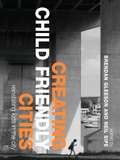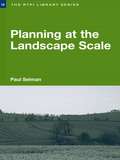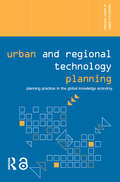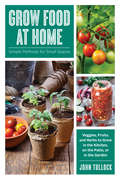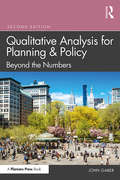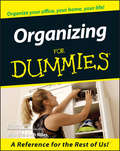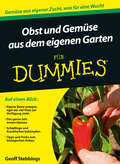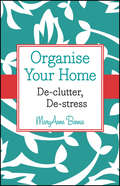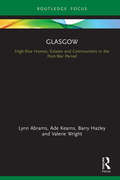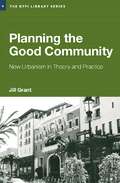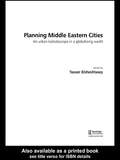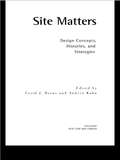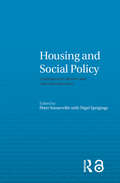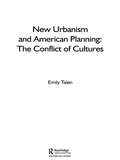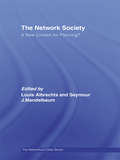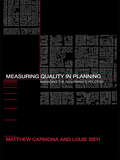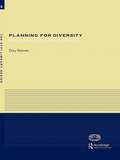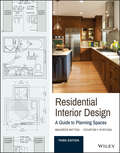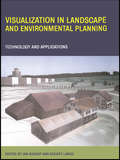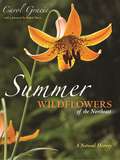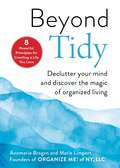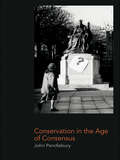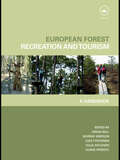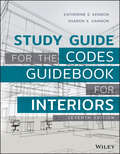- Table View
- List View
Creating Child Friendly Cities: New Perspectives and Prospects
by Brendan Gleeson Neil SipeFirst Published in 2006. Routledge is an imprint of Taylor & Francis, an informa company.
Planning at the Landscape Scale (RTPI Library Series #Vol. 12)
by Paul SelmanTraditionally, landscape planning has involved the designation and protection of exceptional countryside. However, whilst this still remains important, there is a growing recognition of the multi-functionality of rural areas, and the need to encourage sustainable use of the whole countryside rather than just its ‘hotspots’. With an inter-disciplinary assessment of the rural environment, this book draws on theories of landscape values, people-place relationships, sustainable development, and plan implementation. It focuses on the competing influences of globalization and localization, seeing the role of planning as the reconciliation of these conflicting demands, reinforcing character and distinctiveness without museum-izing rural areas. Taking a ‘landscape scale’ approach to the topic, this book responds to the interest sparked by concern for rural landscapes and by recent local and national policy shifts in this area.
Urban and Regional Technology Planning: Planning Practice in the Global Knowledge Economy (Networked Cities Series)
by Kenneth E. Corey Mark WilsonPart of the popular Networked Cities series, Urban and Regional Technology Planning focuses on the practice of relational planning and the stimulation of local city-regional scale development planning in the context of the global knowledge economy and network society. Designed to offer scholars, practitioners, and decision makers studies on the ways of cities, technologies, and multiple forms of urban movement intersect and create the contemporary urban environment, Kenneth Corey and Mark Wilson explore the dynamics of technology-induced change that is taking place within the context of the global knowledge economy and network society. Examining first the knowledge economy itself, Wilson and Corey go on to discuss its implications before proposing ways to strategize for future intelligent development, with particular emphasis on the ALERT model for regional and local planning. An important read for those practicing or studying planning in this network society.
Grow Food at Home: Simple Methods For Small Spaces
by John TullockEverything you need to know to grow good food without a yard Grow food for freshness. Grow food organically. Grow food to connect with nature. Whatever the goal, you don’t need a lot of space to enjoy the benefits of homegrown veggies, herbs, and fruits. In Grow Food at Home, gardening expert John Tullock shows readers just how easy it is to enjoy “farm”-fresh produce grown right on the windowsill, the porch, or in a tiny backyard. Covering artificial lighting, hydroponics, vertical gardening, straw-bale planters, and more, the book offers even the most confined apartment dwellers plenty of options to get growing. Tullock shares all the tips and tricks readers need to make small-space gardening a success, with information on starting seeds, transplanting, succession planting, “crop” rotation, and other procedures—all tailored to the small-space garden—plus recipes to make the most of the harvest. Readers will be energized to grow a mouth-watering selection of micro-crops, from lettuces and herbs to tomatoes, cucumbers, beets, and even small fruits—no matter how little room they have available.
Qualitative Analysis for Planning & Policy: Beyond the Numbers
by John GaberThe revised and updated second edition of Qualitative Analysis for Planning & Policy is a roadmap to help planners access qualitative data and integrate it into their planning investigations. Planning and policy decisions are not based solely on numbers, and this book equips planners with a how-to guide to see what has been missing "between the lines" of quantitative data and make good decisions using the best possible information. Each chapter offers step-by-step instruction on how to set up and enact diverse types of qualitative research, and case studies demonstrate how qualitative research techniques can be combined with quantitative methods to tackle complex real-world projects. For over a decade Qualitative Analysis for Planning & Policy has been an indispensable resource for students and researchers, experienced and novice planners. The revised second edition offers myriad tools to help twenty-first-century planners make intelligent decisions, including new qualitative research techniques, technological innovations, and contemporary case studies.
Organizing For Dummies (For Dummies Ser.)
by Eileen Roth Elizabeth MilesWhat’s the favorite four-letter word of people who are less than fully organized? “Help!” So many technological, social, and economic changes affect your life that you need organization just to keep up, let alone advance. Many people have two jobs – one at the office and one taking care of things at home. If you have a family, you may count that as a third job. Caring for elderly relatives or have community commitments? You can count off four, five, and keep right on going. No matter what life stage you’re in, getting organized can make every day better and help you achieve your long-term goals. Organizing For Dummies is for anyone who wants to Polish his or her professional reputation Experience less stress Increase productivity Build better relationships Maximize personal time Organization isn’t inherited. With the human genome decoded, the evidence is clear: DNA strings dedicated to putting things into place and managing your time like a pro are nonexistent. Instead, organization is a learned skill set. Organizing For Dummies helps you gain that skill with topics such as: Understanding how clutter costs you in time, money, and health Training your mind to be organized and developing a plan Cleaning house, room by room, from basement to attic (including the garage) Creating functional space for efficiency and storage Time-management strategies for home, office, and tavel Scheduling, delegating, and multitasking Making time for your family Managing your health – physical and financial Finding time for love Organizing and cashing in on a great garage sale Getting organized is about unstuffing your life, clearing out the dead weight in places from your closet to your calendar to your computer, and then installing systems that keep the good stuff in its place. Organizing is a liberating and enlightening experience that can enhance your effectiveness and lessen your stress every day – and it’s all yours simply for saying “No” to clutter.
Obst und Gemüse aus dem eigenen Garten für Dummies (Für Dummies)
by Geoff StebbingsFrisches Obst und Gemüse aus dem eigenen Garten Mal eben in den Garten gehen und ein paar Beeren naschen, die selbst angebauten Bohnen ernten oder Zwetschgenkuchen mit Früchten vom eigenen Baum backen − gefällt Ihnen die Vorstellung? Dieses praktische Handbuch gibt Ihnen zahlreiche Tipps und Tricks, wie Sie das ganze Jahr lang leckeres, ernte - frisches Obst und Gemüse aus dem eigenen Garten genießen können: von der Wahl des Werkzeugs über die Auswahl der Pflanzen und Tipps zum biologischen Anbau bis zur ersten Ernte. Geoff Stebbings gibt Ihnen nützliche Ratschläge an die Hand, damit Sie sofort mit der eigenen Gartenarbeit beginnen können und in kurzer Zeit ein erfolgreicher Hobbygärtner werden.
Organise Your Home: De-clutter, De-stress
by MaryAnne BennieIs your clutter taking control of your life? Organise Your Home will show you how to use the in8steps system and organise your entire home without turning it into total chaos in the process. Work at a pace your lifestyle allows and use this tried-and-tested system to completely overhaul your relationship with your stuff. MaryAnne Bennie is an organising expert, speaker and director of in8 home office and life organising.
Glasgow: High-Rise Homes, Estates and Communities in the Post-War Period (Built Environment City Studies)
by Lynn Abrams Ade Kearns Barry Hazley Valerie WrightIn the wake of an unparalleled housing crisis at the end of the Second World War, Glasgow Corporation rehoused the tens of thousands of private tenants who were living in overcrowded and unsanitary conditions in unimproved Victorian slums. Adopting the designs, the materials and the technologies of modernity they built into the sky, developing high-rise estates on vacant sites within the city and on its periphery. This book uniquely focuses on the people's experience of this modern approach to housing, drawing on oral histories and archival materials to reflect on the long-term narrative and significance of high-rise homes in the cityscape. It positions them as places of identity formation, intimacy and well-being. With discussions on interior design and consumption, gender roles, children, the elderly, privacy, isolation, social networks and nuisance, Glasgow examines the connections between architectural design, planning decisions and housing experience to offer some timely and prescient observations on the success and failure of this very modern housing solution at a moment when high flats are simultaneously denigrated in the social housing sector while being built afresh in the private sector. Glasgow is aimed at an academic readership, including postgraduate students, scholars and researchers. It will be of interest to social, cultural and urban historians particularly interested in the United Kingdom.
Planning the Good Community: New Urbanism in Theory and Practice (RTPI Library Series)
by Jill GrantAn examination of new urban approaches both in theory and in practice. Taking a critical look at how new urbanism has lived up to its ideals, the author asks whether new urban approaches offer a viable path to creating good communities. With examples drawn principally from North America, Europe and Japan, Planning the Good Community explores new urban approaches in a wide range of settings. It compares the movement for urban renaissance in Europe with the New Urbanism of the United States and Canada, and asks whether the concerns that drive today’s planning theory – issues like power, democracy, spatial patterns and globalisation- receive adequate attention in new urban approaches. The issue of aesthetics is also raised, as the author questions whether communities must be more than just attractive in order to be good. With the benefit of twenty years’ hindsight and a world-wide perspective, this book offers the reader unparalleled insight as well as a rigorous and considered critical analysis.
Planning Middle Eastern Cities: An Urban Kaleidoscope (Planning, History and Environment Series)
by Yasser ElsheshtawyMiddle Eastern cities cannot be lumped together as a single group. Rather they make up the urban kaleidoscope of the title, as the diversity of the six cities included here shows. They range from cities rich in tradition (Cairo, Tunis, and Baghdad), to neglected cities (Algiers and Sana'a), to newly emerging 'oil-rich' Gulf cities (Dubai). The authors are all young Arab scholars and architects local to the cities they describe, providing an authentic voice with an understanding no outsider could achieve. These contributors move away from an exclusively 'Islamic' reading of Arab cities - which they regard as outdated and counterproductive. Instead, they explore issues of identity and globalization in the context of the struggles and solutions offered by each city from the late nineteenth century to the present day. Their focus is on how the built environment has changed over time and under different influences.
Site Matters: Design Concepts, Histories and Strategies
by Carol J Burns Andrea KahnOne of the trends in twentieth century architecture and planning has been to denigrate and ignore the site, or larger context (both physical and social), surrounding a building or set of buildings. Focussing on Le Corbusier's designs, Site Matters presents that first considered theory and vocabulary for the inevitable reaction against Modernism in planning, beginning in the 1960s and swelling through the 1980s as architects and planners alike developed a new appreciation of site, reincorporating the wider context into their plans. Theoretical essays and empirically grounded pieces combine to provide the language and theory of this re-emergence of site, looking at Le Corbusier's designs, contemporary suburbs, and the planning agendas involved at the World Trade Center site. Groundbreaking and innovative, Site Matters provides valuable theory and vocabulary for planners and architects.
Housing and Social Policy: Contemporary Themes and Critical Perspectives (Housing and Society Series)
by Peter Somerville Nigel SprigingsThis topical book transforms the analysis of housing problems into a lively, interesting and contentious subject of social scientific study, addressing themes of residential experience, inclusion/empowerment, sustainability and professionalism/managerialism, which lie at the heart of the housing and social policy debate. Each chapter considers a specific social category - such as class, gender, or disability - and evaluates the experience and understanding of housing and social policy under this category. With innovative approaches to conceptualising housing and a clear, defined structure, Housing and Social Policy encourages students and practitioners in both arenas to think reflexively about housing as a central instrument of social policy and social experience.
New Urbanism and American Planning: The Conflict of Cultures (Planning, History and Environment Series)
by Emily TalenNew Urbanism and American Planning presents the history of American planners’ quest for good cities and shows how New Urbanism is a culmination of ideas that have been evolving since the nineteenth century. In her survey of the last hundred or so years of urbanist ideals, Emily Talen identifies four approaches to city-making, which she terms ‘cultures’: incrementalism, plan-making, planned communities, and regionalism. She shows how these cultures connect, overlap, and conflict and how most of the ideas about building better settlements are recurrent. In the first part of the book Talen sets her theoretical framework and in the second part provides detailed analysis of her four ‘cultures’.She concludes with an assessment of the successes and failures of the four cultures and the need to integrate these ideas as a means to promoting good urbanism in America.
The Network Society: A New Context for Planning (Networked Cities Series)
by Louis Albrechts Seymour J. MandelbaumIn a clear and rewarding style, Albrechts and Mandelbaum consider the challenges that the new paradigm of the Network Society creates for Urban and Regional Planning. Chapters grouped into five themes discuss theoretical and practical perspectives on the contemporary organization of social, economic, cultural, political and physical spaces. These sections are: models of the Network Society the impact of physical networks such as transport challenges for Planners raised by society’s increased reliance on new technology an examination of local networks including community networks and the possibilities of setting up local networks for disaster recovery a comparison of spatial and policy networks and an exploration of the institutions involved. This book is essential reading for graduate level courses in urban studies, city and regional planning, and urban design. With its clear structure – unitary sections but a diversity of perspectives – the book can be used easily in courses such as Planning Theory, Urban Infrastructure and Public Policy.
Measuring Quality in Planning: Managing the Performance Process
by Matthew Carmona Louie SiehThis book deals with one of the current major debates in planning: how to measure the quality and effectiveness of the output of the planning process. It deals with issues of defining quality, public sector management, the use of indicators and the planning process. Although case study material is drawn from UK practice this topic is universal and the authors include discussions of international practice and experience.
Planning for Diversity: Policy and Planning in a World of Difference (RTPI Library Series #Vol. 8)
by Dory ReevesThe practical importance of diversity and equality for spatial planning and sustainable development is still not widely understood. Using international examples, this book shows planners and educationalists the benefits of building in a consideration of diversity and equality at each stage and level of planning.Despite being one of the most diverse and gender balanced of the built environment professions, complacency has been widespread in planning. This book shows why a diverse profession is important and drawing on a wide range of good practice, shows how those involved in planning can develop their sensitivity to and expertise in diversity and equality.
Residential Interior Design: A Guide to Planning Spaces
by Maureen Mitton Courtney NystuenA Room-by-room guide to home interior design More than a decorating guide, Residential Interior Design teaches the fundamental skills needed to plan interior spaces for all types of homes, in all decorative styles, from remodeling to new construction. Taking a step-by-step approach, this valuable primer reviews all aspects of interior architecture as it relates to human factors and daily use. Authors and interior designers Maureen Mitton and Courtney Nystuen explore the minimal amount of space necessary in order for rooms to function usefully, from the kitchen to the bathroom, the bedroom to the hallway, and every room in between. Packed with hundreds of drawings and photographs, this valuable tool is brimming with useful information regarding codes, mechanical and electrical systems, the Americans with Disabilities Act, accessibility codes, special considerations for multi-family dwellings, and a variety of additional factors that impact each type of room and its corresponding space. With a focus on quality of design over quantity of space, Residential Interior Design is the first stop to designing equally efficient and attractive rooms.
Residential Interior Design: A Guide To Planning Spaces
by Maureen Mitton Courtney NystuenA practical approach to planning residential spaces Residential Interior Design: A Guide To Planning Spaces is the industry-standard reference for all aspects of residential space planning, with a practical focus on accessible design, ergonomics, and how building systems affect each space. This new third edition has been updated with the most recent code information, including the 2015 International Residential Code and the International Green Construction Code, and new content on remodeling. Packed with hundreds of drawings and photographs, this book illustrates a step-by-step approach to design that applies to any residential space, and ensures that the most important factors are weighted heavily in the decision making process. Daily use is a major consideration, and the authors explore the minimum amount of space each room requires to function appropriately while examining the host of additional factors that impact bedrooms, bathrooms, kitchens, hallways, and more. Detailed information about accessibility is included in each chapter, making this book a reliable design reference for "aging in place" and universal design. The new companion website features teaching tools and a variety of learning supplements that help reinforce the material covered. Interior design is a fundamental component of a residential space, and a required skill for architecture and design professionals. This book is a complete reference on all aspects of residential design, and the factors that make a space "work." Design spaces with primary consideration of daily use Account for building systems, accessibility, human factors, and more Get up to date on the latest residential interior building codes Plan interiors for any home, any style, and any budget Designing a residential interior is about more than choosing paint colors and furniture—it's about people, and how they interact and use the space. It's about shaping the space to conform to its function in the best possible way. Residential Interior Design provides clear, comprehensive guidance on getting it right every time.
Visualization in Landscape and Environmental Planning: Technology and Applications
by Ian D. Bishop Eckart LangeThis major reference presents the challenges, issues and directions of computer-based visualization of the natural and built environment and the role of such visualization in landscape and environmental planning. It offers a uniquely systematic approach to the potential of visualization and the writers are acknowledged experts in their field of specialization. Case studies are presented to illustrate many aspects of landscape management including forestry, agriculture, ecology, mining and urban development.
Summer Wildflowers of the Northeast: A Natural History
by Carol GracieFrom the acclaimed author of Spring Wildflowers of the Northeast, a beautifully illustrated follow-up introduction to the summer-blooming wildflowers of the northeastern United States and CanadaThis exquisitely illustrated volume provides an accessible, in-depth introduction to summer-blooming wildflowers of the northeastern United States and Canada. Featuring more than 700 detailed color photos and a large, beautifully designed format, the book delves into the life histories of more than thirty-five wildflowers and their relatives, from common roadside favorites, such as asters and milkweeds, to interesting, lesser-known species, including Indian pipe and ginseng. Drawing on a wealth of personal experience and the latest scientific research, and presenting it all in terms anyone can understand, acclaimed naturalist and photographer Carol Gracie invites readers to enhance their appreciation of the beauty of these wildflowers by learning not just their names or how many petals they have, but what pollinates them, how their seeds are dispersed, how they interact with other plants and animals, how Native Americans and other people have used them, and other interesting facts.Each species is illustrated with a range of detailed color photos that not only capture its beauty but illustrate the features discussed in the text and show the plant in its environment alongside the pollinators, herbivores, or seed dispersers with which, in many cases, the wildflower has evolved. Other topics covered include the naming of wildflowers; pathogens and pests; related species in other parts of the world; and wildflowers in history, literature, and art.Presenting authoritative information in an inviting style, Summer Wildflowers of the Northeast is an ideal volume for wildflower lovers, outdoor enthusiasts, naturalists, students, and more.Showcases the most spectacular summer-blooming wildflowers of the northeastern United States and CanadaFeatures more than 700 stunning full-color photosCovers the life histories, lore, and uses of more than 35 species and their relativesCombines the latest scientific research with an easy-to-read styleFeatures species accounts for these wildflowers:Alpine Wildflowers ● American Cranberry ● American Ginseng ● American Lotus ● Asters ● Beechdrops ● Blackberry-lily ● Bog Orchids ● Broad-leaved Helleborine ● Buckbean ● Bunchberry ● Cardinal Flower ● Chicory ● Common Milkweed ● Common Mullein ● Evening-Primrose ● Fringed Gentian ● Fringed Orchids ● Goldenrods ● Grass-of-Parnassus ● Indian Pipe ● Jewelweed ● Jimsonweed ● Lilies ● Patridge-berry ● Passion-flowers ● Pipsissewa ● Prickly Pear ● Purple Pitcher Plant ● Queen Anne’s Lace ● Showy Lady-slipper ● Swamp Rose-mallow ● Wild Leek ● Wild Lupine ● Yellow Pond-lily
Beyond Tidy: Declutter Your Mind and Discover the Magic of Organized Living
by Annmarie Brogan Marie LimpertThe Top Ways to Declutter, Organize, and Get your Life Back in Place! Are you overwhelmed by clutter and disorganization, or are you already organized but want to take it to the &“next level?&” Either way, you&’re in the right place! Go beyond the tidying effects of Marie Kondo and other professional organizers. Discover not only the best ways to declutter and organize, but also how to create a positive growth mindset that will keep you motivated and solution-focused. Learn to plan for obstacles and stay resilient throughout the organizing process, all while moving through it with self-compassion and a newfound vision of what&’s possible. Included in this easy-to-read handbook are sections that discuss pertinent topics such as: Setting Manageable GoalsSorting Through Your BelongingsCreating AssociationsManaging Your SpaceFinishing the Task!Defining Different Types of ClutterAnd more! Using eight simple but powerful principles coupled with the science of positive psychology, the authors, founders of Organize Me! of NY, LLC, a New York-based organization consulting company, help you to declutter and organize effectively. With an empowering and non-judgmental approach, they demonstrate how organization (and disorganization) impacts our home, relationships, quality of life and overall wellbeing. With this guide, you will discover how each principle saves you time, money, space and energy, giving you more to spend on family and activities you love. There are many reasons why people become disorganized and have cluttered spaces. However, none of them have to stop you from getting your home, your office, or any other aspect of your life sorted out and headed back in the right direction. With these newfound skills, you&’ll be empowered to go &“beyond tidy&” to create a home and life you love!
Conservation in the Age of Consensus
by John PendleburyThis new text on the subject of conservation in the built environment provides a unique holistic view on the understanding of the practice of conservation connecting it with wider societal and political forces. UK practice is used as a means, along with international examples, for bringing together a real understanding of practice with a social science analysis of the issues. The author introduces ideas about the meanings and values attached to historic environments and how that translates into public policies of conservation.
European Forest Recreation and Tourism: A Handbook
by Simon Bell Murray Simpson Liisa Tyrväinen Tuija Sievänen Ulrike PröbstlIn an increasingly urbanized world more and more people are turning to our forests and woodland for recreation and tourism. Planning and providing for this growing demand poses challenges that need to be addressed by managers and designers alike. Based on a study of forest recreation from across Europe, the editors bring together the expertise of more than eighty leading professionals and academics to provide a clear and concise guide to best practice. Case studies and careful research give a detailed insight into the issues that forest recreation raises, from strategic planning to integration into the existing rural economy. Essential reading for tourism planners, landscape designers and countryside managers delivering forest recreation and tourism.
Study Guide for The Codes Guidebook for Interiors: Wiley E-text Folder And Interactive Resource Center Access Card
by Katherine E. Kennon Sharon K. HarmonThe comprehensive study guide for understanding interior codes This revised and updated seventh edition of the Study Guide for the Codes Guidebook for Interiors is an essential companion to The Codes Guidebook for Interiors, the industry's reference of choice, with complete coverage of the major codes and standards that apply to interior projects. This Study Guide includes term lists, practice questions, practical application exercises, code tables, checklists, and a book companion site featuring interactive checklists, helping designers and architects check their knowledge and comprehension from reading The Codes Guidebook for Interior chapters and prepare for the NCIDQ and ARE exams. Since The Codes Guidebook for Interiors text covers the latest requirements, standards, terminology, and federal regulations, including the 2015 ICC, the current ADA standards, and ICC/ANSI requirements as well as information on green construction, this companion study guide is a comprehensive measure of designers understanding and application of codes for interior projects. It can help design students learn and practitioners keep their skills up to date. Because it is vital that designers and architects have an up-to-date working knowledge of the various codes involved with building interiors, whether during renovation or new construction, the study guide offers them an opportunity to: Check their knowledge of the key terms of the industry Test their working knowledge of codes using the practice questions and problem scenarios Utilize the code tables during the design process Employ the numerous checklists on proposed and real life projects to ensure complete compliance The revised Study Guide is a useful companion to The Codes Guidebook for Interiors, the essential reference for all interior professionals. Check your understanding of the individual chapters as exam prep or even just as a self-test. For the designer, architect, or student, the Study Guide for The Codes Guidebook for Interiors is a must-have resource.
